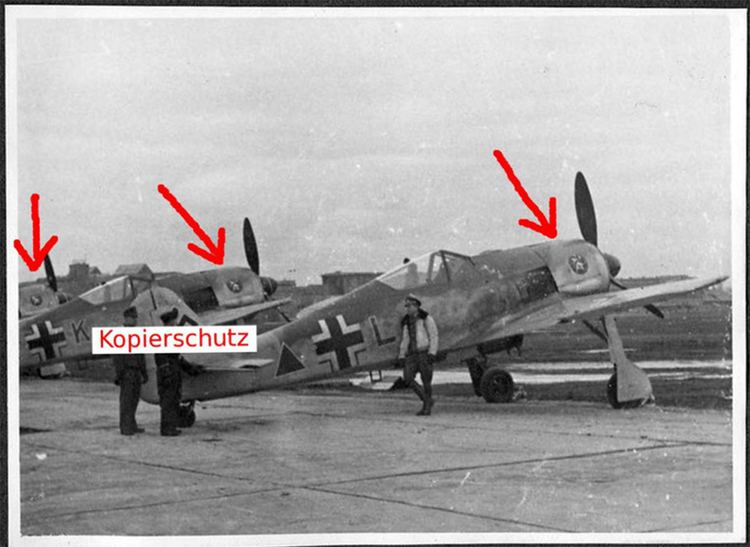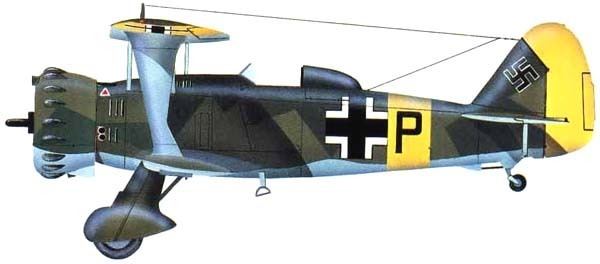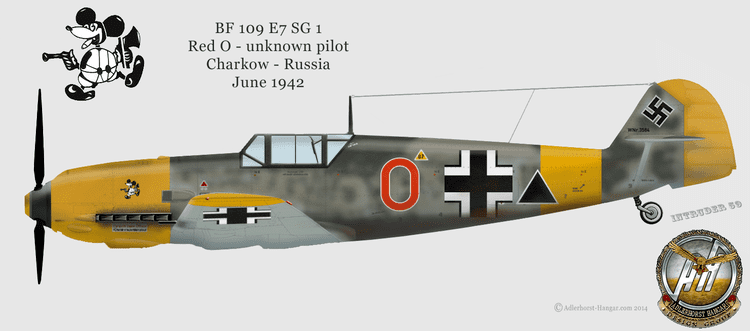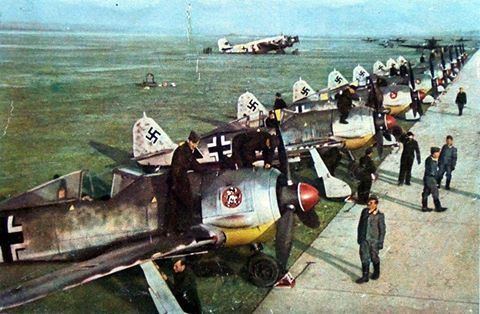Active 1942–431943–45 | Type Ground-attack Size Air Force Wing | |
 | ||
Similar Schlachtgeschwader 2, Lehrgeschwader 1, Lehrgeschwader 2, Kampfgeschwader 4, Nachtjagdgeschwader 2 | ||
Schlachtgeschwader 1 (SchlG 1, since 1943 rather SG 1) was a German ground-attack wing during World War II. The first formation was on 13 January 1942, from the II.(Schl)/Lehrgeschwader 2, initially with two Gruppen each made of four Staffeln. The second formation was on 18 October 1943, by renaming the existing Sturzkampfgeschwader 1 (StG 1). The new unit's name became abbreviated simply SG 1.
Contents
- The first formation
- Crimea 1942 3
- North Africa
- The retreat in Russia
- Kursk 1943
- Independent 4PzSchlG 1
- Independent 8PzSchlG 1
- Disbanding and the second formation
- Kommodore
- ISG 1
- IISG 1
- IIISG 1
- References

The first formation

Schlachtgeschwader 1 of the Luftwaffe was formed on 13 January 1942 at Werl. I/SchlG 1 was outfitted with Messerschmitt Bf 109E-7s. As of II/SchlG 1, the 5th and 6th Staffeln were equipped with Henschel Hs 129B-1s, and the 7th Staffel with Henschel Hs 123As. The 7th Staffel took over the aircraft of the 8th Staffel in April 1942. In the same month, the training was completed, and the wing was ordered to the Crimea for duty with IV Fliegerkorps, Luftflotte 4.
The 4th Staffel and the 8th Staffel, while formally part of SchlG 1, operated independently.
Crimea 1942-3

After arrival operations started with ground attack missions in the Eastern Crimea in May 1942, and then over the Izyum Salient southeast of Kharkov to the end of the month. Outfitted with Bf 109E-7s, I/SchlG 1 was based at Itshki-Grammatikovo, the Gruppe was assigned to VIII Fliegerkorps for support of 11th Army's in the Kerch Peninsula. Attacks were carried out against Soviet positions along the front, on troop and supply columns immediately behind the front. Such was the effect that German infantry assault units were able to break through the forward defenses on 8 May, the first day of the attack, and took the town of Kerch on 15 May. Losses to the Gruppe were two Bf 109E-7s on 11 May, both shot down by AA fire. Three Hs 129B-1s were shot down by AA fire on 23 May.

Altogether SchlG 1 flew nearly 1,500 sorties during May 1942 with a 1,000-plus missions with the Bf 109E, 259 with the Hs 123 and some 180 with the new Hs 129A. The unit later moved to Tatsinskaya in July and Tusov in August to support the 6th Army during the drive to the Don, and later Stalingrad, which began on June 25. Few losses were recorded during intense action, but I/SchlG 1 did lose two Bf 109E-7s, one shot down over Voronezh and the other on the Don on 4 July. II Gruppe was temporarily split up during this period with the Staffeln operating independently on the central sector of the front. 6th Staffel lost two Hs 129B-1s to AA on 28 June and three Hs 123As from 7th Staffel were lost northeast of Kursk on 29 June. The rapid advance of the German forces resulted in rapid transfers though the summer. Autumn losses in the Stalingrad area were very light. Around mid-August 1942, a further move was made to Tusov which became the home base for the I Gruppe until late November.
North Africa

5th Staffel was transferred to East Prussia in October to rest and refit with the Hs 129B-2. It departed for North Africa on 5 November 1942 and arrived in Tunis on 29 November. It flew its first combat mission the next day against British tanks and vehicle columns near Tebourba, followed by numerous missions over the next month. It was renamed 8.(Pz)/SchlG 2 in January 1943. A few weeks later, the new 5./SchlG 1 was formed in Germany, equipped with the Fw 190.
The retreat in Russia

The Soviet counter-offensive at Stalingrad erupted on 19 November 1942 causing surprise and mayhem. On 22 November I/SchlG 1 was forced to blow up several its unserviceable Bf 109E-7s, just days after the start of the Soviet counter-offensive that eventually encircled the German 6th Army. The unit was forced to abandon its base at Oblivskaya on 26 November and withdraw to the west. II Gruppe also began a maximum effort around Stalingrad at the cost of at least eight Hs 129Bs, Hs 123As and Bf 109Es lost in ground attack missions or blown up to prevent capture by the on-coming Russians.
Four Bf 109E-7s of I Gruppe were lost in December, two to Soviet fighters, as I/SchlG 1 was forced back to Millerovo. On 31 December the 3. Staffel lost Staffelkapitän Oblt. Josef Graf von und zu Hönsbröck, killed by ground fire. By 22 December what was left of II/SG 1 had also been pulled back, to Voroshilovgrad.
In 1942 II Gruppe had flown 3,128 Hs 129 sorties, 1,532 Hs 123 sorties, and 1,938 Bf 109 sorties, claimed 107 aircraft shot down or destroyed, and lost 20 Hs 129s, 16 Bf 109s, and 5 Hs 123s to enemy action.
During early 1943 the staff was located in the Donets Basin area, two Bf 109E-7s from 2nd Staffel being lost to enemy fire on 10 February. On 16 February, the Soviets recaptured Kharkov and the Germans counter-attacked to retake the city two weeks later. SG 1 supported, and as soon as the city was again under German control it moved to Kharkov-North on 14 March.
The SG 1 continued operations during the spring and summer while converting to the Focke Wulf Fw 190. The conversion of I Gruppe was completed by the end of April, though several Bf 109s remained on strength. II Gruppe converted to the Fw 190A-5 which was completed by early March, transferring to central Ukraine for a month of training before moving back to the front in April 1943.
The ground attack missions in support of the cut-off 17th Army in the Kuban bridgehead were intense and costly, as the Soviet Air Force outnumbered the Luftwaffe four-to-one and large numbers of AA guns were present in the area. 7 Fw 190A-5s of II Gruppe were shot down in May 1943, most falling to AA fire. June also saw the first arrivals of the new heavily armoured Fw 190F-3 aircraft.
Kursk 1943
Participating in the Operation Zitadelle during July 1943, the I/SchlG 1 was ordered north to Orel to pin down the Soviet counter-offensive. Non-stop operations between 8 July and 2 August saw I Gruppe loss of eight Fw 190s to AA fire, including one piloted by Obstlt. Horst-Wilhelm Hossfeld, a general staff officer on 17 July. II/SchlG 1 did not get involved in heavy fighting until the Russian spearheads began to close around in early August.
As the Soviets advanced, Orel fell on 4 August and I Gruppe was forced back, to Bryansk. By September the Gruppe was shifted to the northern Ukraine to support defence of Kiev.
Hptm. Johannes Meinecke, Staffelkapitän of the 1st Staffel, was killed by AA fire near Mutino on 4 September 1943. Three Fw 190F-3s were lost on 27 September and another F-3 and on 6 October a Fw 190A-6 was shot down, killing the new Staffelkapitän of 1st Staffel Hptm. Josef Menapace. On 13 October, two more Fw 190F-3s were shot down by Soviet fighters.
II/SchlG 1 was forced to withdraw to the west to Kiev-South. Losses in September and October were relatively light, averaging one aircraft per week.
Independent 4.(Pz)/SchlG 1
The 4th Staffel was formed in January 1942 as a component of II/SchlG 1 with Bf 109Es provided by the disbanded II (Schl.)/LG 2. It operated as an independent, autonomous unit for much of its existence. It flew under VIII Fliegerkorps after receiving 16 of the new Henschel Hs 129B-1.
Commencing operations on 7 May 1942 the unit attacked various ground targets, shot down an Polikarpov I-16 fighter and destroyed some 40 other aircraft during low-level strafing attacks on enemy airfields in Eastern Crimea. In mid-May the Staffel moved with the rest of II Gruppe and took part in the heavy fighting to the south and south-east of Kharkov. In early June the aircraft were fitted with the new MK-101 30 mm cannon 'underbelly' pack, and first went into action against Soviet tanks retreating along the Don River. Their first loss was a Hs 129 on 6 July.
Following the Soviet counter-offensive at Stalingrad the Staffel was deployed west of Stalingrad. After withdrawing to Stalino it was re-equipped with the new Hs 129B-2 and transferred to Stalino-North during April. The Staffel supported the German ground forces on the Taman Peninsula, south west of Rostov.
In June 1943 the staffel was sent back to Germany, to be fitted with the new 30 mm MK-103 armour-piercing cannon, ready for the upcoming Operation Zitadelle.
Losses were heavy in July with 7 Hs 129B-2s falling to AA fire. The Staffel then assisted in the defence against the Soviet counter-attack towards Orel of 13 July. The unit moved to Poltava at the end of August. 6 aircraft were lost in September as the Staffel retreated through central Ukraine.
Independent 8.(Pz)/SchlG 1
Although 8.(Pz)/SchlG 1 was officially a Staffel of I/SchlG 1 from January 1942, it operated independently. It returned to Germany in April 1942, and re-equipped with Bf 109E-7s, and their Hs 123 biplanes turned over to 7th Staffel. After its conversion to the Hs 129 in January 1943 it was categorized as a "tank-buster" unit.
8.(Pz)/SchlG 1 returned to southern Russia in February 1943. By April it was sent to the North Caucasus to support the Kuban bridgehead. Very heavy losses were suffered in the fighting over Kuban, nine aircraft being lost by the end of May.
8.(Pz)/SchlG 1 withdrew the southern Ukraine in June 1943 to re-equip. In July, the Staffel was deployed for Operation Zitadelle, the German offensive against the Kursk salient.
Losses were again heavy as the Staffel attacked Soviet armour east of Kursk. The unit was ordered to Orel-West on 15 July to counter the powerful attack toward Orel which begun two days earlier. In September 1943, the Staffel was committed in the rear-guard fighting between Kharkov and Kiev. After losing five Hs 129s that month, it moved to Kiev.
Disbanding and the second formation
SchlG 1 gradually withdrew to become fully stationed in Kiev in October 1943. On 18 October 1943, the Stab (staff) was disbanded and the personnel used to form the staffs of IV/SG 9, NSGr 3, and NSGr 7. Both Gruppen moved to other formations: the I/SchlG 1 was renamed the II/SG 77, except for the 1st Staffel which was disbanded and incorporated into the other Staffeln, and the II/SchlG 1 was renamed the II/SG 2, with 5th Staffel becoming 8th Staffel and the others retaining their numbers.
At the same time the independent Staffeln also became renamed: the 4.(Pz)/SchlG 1 was renamed to the 10.(Pz)/SG 9, and the 8.(Pz)/SchlG 1 was renamed 11.(Pz)/SG 9.
